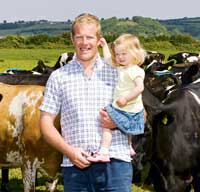Grass management key to dairy success

For Somerset dairy farmer, Mat Boley, the emphasis has always been on simplifying the system as much as possible. And for him, once a day milking on a low-cost, grass-based system has proved the answer.
“Grass is the cheapest and simplest way of feeding cows. We rely completely on grass and feed no concentrate whatsoever.
“My aim is to be in the top 5% of dairy farmers for financial performance by maximising profit/hour worked, while at the same time having the best life style a farmer can have.”
The spring block calving herd at Batch End Farm, Lympsham, is made up of 370 primarily New Zealand Friesian cross Jerseys cows which are at grass for the majority of the year, with just half the herd housed from December to February.
“Half the herd are housed on cubicles and self-fed silage over the winter and the rest are out-wintered on grass and round-baled silage.”
And milking once a day and feeding a grass-only diet is the best way to meet the needs of our milk contract, he says.
“We need to maximise milk solids to suit our cheese contract and this system is ideal.
“Increase in milk quality is commonly associated with once-a-day milking and we have seen a marked increase in solids since switching from twice a day.”
In fact milk protein has increased by 10% and fat by 5% and the herd is now averaging 4% protein and 5% fat.
“After good management, genetics is the most important factor for the success of this system,” says Mr Boley. “In my opinion, nothing beats proven New Zealand genetics for this system – at certain times of year, conditions are tough and grass may run short, but these cows can cope.”
Mr Boley is involved with the Livestock Improvement Corporation (LIC) grass mentoring scheme and has also worked closely with “mentor” Johnny Ryder to ensure he gets the most out of grass.
“The key is to be proactive rather than reactive when it comes to grass management,” he says. “We run a rotational paddock grazing system and use a grass plate meter once a week during the growing season to produce a feed wedge.”
Grass is grazed strictly to a residual of 1500kg DM/ha. “To maximise intakes, we ensure we select grass mixes that have been trialled for palatability and cow preference.”
About 5% of the farm is reseeded with a perennial ryegrass and white clove cutting and grazing mix every year. “To guarantee good establishment, in the last 3-4 years we have sown all reseeds with peas and barley,” Mr Boley explains.
“In conventional systems, most farmers would apply nitrogen after establishment, but because we are organic, we cannot do this – because peas are legumes, this means they improve nitrogen fixing.”
And because herbicides cannot be used, planting fast-establishing peas and barley means weeds are out-competed.
“Because our reseed leys contain peas and barley, we are producing a certain amount of mixed silage, but 80-90% of the diet is still grass based. Planting this mix is purely for establishment reasons, rather than diet choice.”
Traditionally, the farm reseeded in autumn, but recently they have moved to spring reseeds. “Reseeding in spring gives us more flexibility as there is more grass available for the cows and it is easier to take fields out.”
However, the extended cold period this spring could create new problems with grazing this season, he says.
“This year could offer a potential challenge as grass has simply not got going. If grass doesn’t start growing in the next week we may have to supplement cows with grass silage at grass – something we have never had to do.”
Fortunately, two “grassy” summers mean silage stocks are still relatively good, so it should not be necessary to buy in stocks.
Mr Boley will be one of two farmers hosting this year’s RABDF, BGS and DairyCo grassland spring walk, entitled “Milking Grass for Profit”.
Dates and locations
Tuesday 30 March – Mat Boley, Mill Shed Farm, Lympsham, Weston-Super-Mare, Somerset
Thursday 8 April – David and Rachel Lee, Winnington Green Farm, Middleton, Welshpool
Pre-register your place by contacting Laura Dickinson on 0845 458 2711 or email lauradickinson@rabdf.co.uk
